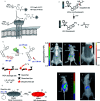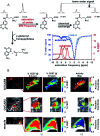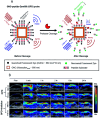Recent progress in the imaging detection of enzyme activities in vivo
- PMID: 35530057
- PMCID: PMC9070033
- DOI: 10.1039/c9ra04508b
Recent progress in the imaging detection of enzyme activities in vivo
Abstract
Enzymatic activities are important for normal physiological processes and are also critical regulatory mechanisms for many pathologies. Identifying the enzyme activities in vivo has considerable importance in disease diagnoses and monitoring of the physiological metabolism. In the past few years, great strides have been made towards the imaging detection of enzyme activity in vivo based on optical modality, MRI modality, nuclear modality, photoacoustic modality and multifunctional modality. This review summarizes the latest advances in the imaging detection of enzyme activities in vivo reported within the past years, mainly concentrating on the probe design, imaging strategies and demonstration of enzyme activities in vivo. This review also highlights the potential challenges and the further directions of this field.
This journal is © The Royal Society of Chemistry.
Conflict of interest statement
There are no conflicts to declare.
Figures













Similar articles
-
Recent advances in aggregation-induced emission luminogens in photoacoustic imaging.Eur J Nucl Med Mol Imaging. 2022 Jul;49(8):2560-2583. doi: 10.1007/s00259-022-05726-8. Epub 2022 Mar 12. Eur J Nucl Med Mol Imaging. 2022. PMID: 35277741 Review.
-
Strategies for in vivo imaging of enzyme activity: an overview and recent advances.Chem Soc Rev. 2011 Jul;40(7):4186-216. doi: 10.1039/c1cs15035a. Epub 2011 May 9. Chem Soc Rev. 2011. PMID: 21552609 Review.
-
Recent advances in high-speed photoacoustic microscopy.Photoacoustics. 2021 Aug 14;24:100294. doi: 10.1016/j.pacs.2021.100294. eCollection 2021 Dec. Photoacoustics. 2021. PMID: 34458095 Free PMC article.
-
Advances in Imaging Techniques and Genetically Encoded Probes for Photoacoustic Imaging.Theranostics. 2016 Oct 7;6(13):2414-2430. doi: 10.7150/thno.15878. eCollection 2016. Theranostics. 2016. PMID: 27877244 Free PMC article. Review.
-
Recent progresses in small-molecule enzymatic fluorescent probes for cancer imaging.Chem Soc Rev. 2018 Sep 17;47(18):7140-7180. doi: 10.1039/c7cs00862g. Chem Soc Rev. 2018. PMID: 30140837 Review.
Cited by
-
Recent advances in ratiometric fluorescence imaging of enzyme activity in vivo.Curr Opin Chem Biol. 2024 Jun;80:102441. doi: 10.1016/j.cbpa.2024.102441. Epub 2024 Mar 7. Curr Opin Chem Biol. 2024. PMID: 38457961 Free PMC article. Review.
-
In Situ Generated Novel 1H MRI Reporter for β-Galactosidase Activity Detection and Visualization in Living Tumor Cells.Front Chem. 2021 Jul 15;9:709581. doi: 10.3389/fchem.2021.709581. eCollection 2021. Front Chem. 2021. PMID: 34336792 Free PMC article.
-
New directions of activity-based sensing for in vivo NIR imaging.Chem Sci. 2020 Jul 3;12(10):3393-3405. doi: 10.1039/d0sc03096a. Chem Sci. 2020. PMID: 34163614 Free PMC article. Review.
-
Monitoring Enzyme Activity Using Near-Infrared Fluorescent Single-Walled Carbon Nanotubes.ACS Sens. 2024 May 24;9(5):2237-2253. doi: 10.1021/acssensors.4c00377. Epub 2024 Apr 26. ACS Sens. 2024. PMID: 38669585 Free PMC article. Review.
-
Parameter Reliability and Understanding Enzyme Function.Molecules. 2022 Jan 1;27(1):263. doi: 10.3390/molecules27010263. Molecules. 2022. PMID: 35011495 Free PMC article. Review.
References
Publication types
LinkOut - more resources
Full Text Sources
Miscellaneous

